Aug 29, 2024 | Patent
A. Introduction
Augmented Reality Technology (AR) displays a transformative leap in the way of interaction with the digital and physical platforms. By overlaying the computer-generated images, sounds and sensory enhancements onto our everyday real surroundings, AR bridges the gap between the virtual and real by creating a mixed-reality experience thereby enhancing the user’s way of perceiving and interaction.
AR Technology integrates digital information with the user’s environment in the real-time. AR overlays digital content onto our physical world even through devices such as smartphones, tablets, AR glasses etc., unlike Virtual Reality (VR) which immerses the users in a completely different kind of virtual world. The scope of AR extends across various domains like gaming, education, healthcare, manufacturing and navigation etc.
Key components of AR technology include:
- Sensors and Cameras, which captures the physical surroundings and tracks the user movements.
- Processors which handles the computational load which is required to integrate and display augmented content in the real-time world.
- Displays which projects the augmented content onto the user’s view, ranging from simple screens to the advanced displays.
- Software Algorithms which facilitates the interaction between the digital and physical realms through object recognition, tracking and the rendering techniques.
AR Technology has penetrated various sectors thereby offering new ways to enhance the user experiences. In healthcare, AR assists in medical training and complex operations while in retail, it enables virtual try-ons and interactive advertisements. In education, it brings subjects to life by using interactive learning modules whereas in the gaming industry, the success of games like Pokémon GO showcases AR’s potential to revolutionize entertainment.
The rapid growth of AR Technology is reflected in the increasing number of the filings of patents. Patents in this domain encompass hardware innovations, software advancements, user interface designs and specific application techniques. Leading technology companies such as Apple, Google, Microsoft and emerging startups are heavily investing in the AR-related R&D thereby resulting in a very competitive patent landscape.
This report delves into the patent landscape of AR technology, providing key insights into key players, technological trends and the competitive dynamics shaping the future of augmented reality. By analyzing patent filings and grant trends, it aims to offer a comprehensive view of the intellectual property landscape that is driving the AR industry forward.
- Objective of Patent Landscape
We, at Origiin, prepared this Patent Landscape Report for AR Technology to understand various trends with regard to patent activity in this space. We have analyzed the patents filed, published and granted between 2022 and 2024. The search strategy used to generate the data to prepare the report is based on a combination of predetermined International Patent Classification (IPC) codes, as well as specific keywords.
We observed that the companies based in the India, United States and World Intellectual Property Organization are the major contributors of patent filings in the area of AR Technology. The leading patent filing companies include the Chandigarh University , Chitkara University and RV University.
C. Parameters used for Patent Landscape analysis
In this report, we studied the following parameters and trends:
- Patenting Trends for the year 2022 to 2024
- Distribution of Patents based on the Assignees
- Jurisdiction based Global Patent Filing Trends
- Technology classification based on IPC classification
- Activities of Competitors based on area of Research (IPC)
- Estimated top 10 industries and technology areas between 2022 and 2024
- Estimated top 10 owners between 2022 and 2024
- Estimated top 10 Assignee Countries between 2022 and 2024
- Estimated top 10 priority countries between 2022 and 2024
- Estimated top 10 publication countries between 2022 and 2024
D. Patent filing trend between years 2022 to 2024
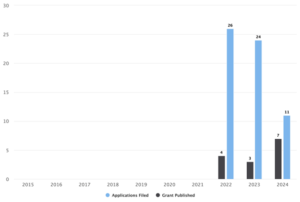
Figure 1: Patent filing trend between the years 2022 to 2024
The Figure 1 depicts the distribution of patents for AR Technology between the years 2022 to 2024, including both applications filed and granted patents. The graph shows that highest number of applications were filed in 2022 with 26 patents followed by 2023 with 24 patents. However, the lowest number of patents were granted in the year 2023 with 03 patents compared to 2022 with 04 patents and 2024 with 07 patents. Overall, filings for AR Technology patent families is gradually increased in the time period between 2022 and 2024.
E. Distribution of Patents based on the Assignees
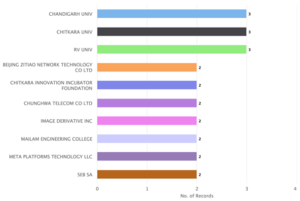
Figure 2: Distribution of Patents based on the Assignees
As indicated in Figure 2, Chandigarh University is the key player with 03 patents along with Chitkara University and RV University each. The next key players are Beijing Zitiao Network Technology Company Ltd., Chitkara Innovation Incubator Foundation, Chunghwa Telecom Company Ltd., Image Derivative Inc, Mailam Engineering College, Meta Platforms Technology LLC and Seb S.A who holds 02 patents each.
F. Jurisdiction based Global Patent Filing Trends

Figure 3: Distribution of Patent based on the jurisdiction
The Figure 3 shows the distribution of patents based on the jurisdiction. The maximum number of patents, i.e, 29, were filed in the IN (India) and rest of the patents were issued in the other jurisdictions, such as, United States (US) with 22 patents, World Intellectual Property Organization (WO) with 13 patents followed by European Patent Office (EP) with 10 patents and Taiwan (TW) with 10 patents, China (CN) with 09 patents, Russia(RU) with 07 patents, Turkey (TR) with 06, Japan (JP) with 04 patents and France (FR) with 03 patents.
G. Technology classification based on IPC classification
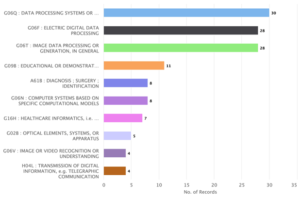
Figure 4: AR Technology Patent Distribution based on main IPC Code Classification
The Figure 4 indicates the patent distribution based on main IPC code. The top spot is occupied by the data processing systems or methods, specially adapted for administrative, commercial, financial, managerial, supervisory or forecasting purposes with 30 patents families. Other major players include Electric digital data processing and Image data processing or generation, in general with 28 patent families each followed by educational or demonstration appliances; appliances for teaching, or communicating with, the blind, deaf or mute; models; planetaria; globes; maps; diagrams with 11 patent families. Diagnosis: surgery: identification follows along with Computer systems based on specific computational models with 08 patents each while the next in line i.e., Healthcare Informatics hold 07 patents and Optical elements, systems or apparatus hold 05 patents. Image or video recognition or understanding and Transmission of digital information hold 04 patents each.
H. Activities of Competitors based on Area of Research (IPC)

Figure 5: Augmented Reality Technology (AR) Distribution of Patent based on Competitors and Area of Research (IPC)
The Figure 5 depicts the distribution of patents based on competitors and area of research (IPC). The top spot occupied by IPC G06T19/00 i.e, manipulating 3D models for images for computer graphics holds 24 patents. Other major players includes G06Q30/06 i.e, buying, selling or leasing transactions with 09 patent families and input arrangements or combined input and output arrangements for interaction between user and computer with 08 patent families. IPC G06Q30/02 for marketing with 06 patent families. Sound input: Sound output, using wireless devices, education, editing of 3D images and teaching not covered by other main groups of this subclass with 04 patents each. IPC A61B5/00 Measuring for diagnostic purposes holds 03 patents.
I. Estimated top 10 Industries and Technology areas between 2022 and 2024

Figure 6: Augmented Reality Technology (AR) Distribution of Patent based on Industries & Technology.
The Figure 6 indicates major industries and technology areas between 2022 and 2024. Computers and Peripheral Equipment is the major industry in the field. Computer Programming, Consultancy and Related Activities follows next with 29 patents. The next in line is Medical and Dental Instruments and Supplies with 12 patents. The Manufacturing N.E.C Industry holds 11 patents while the Other General Purpose Machinery has 09 patents. The Communication Equipment has 08 patents followed by Optical Instruments and Photographic Equipment with 05 patents. Other Manufacturing and Specialised Construction Activities holds 03 patents each. The least in number is the Domestic Appliances with 02 patents.
J. Estimated top 10 Owners between 2022 and 2024
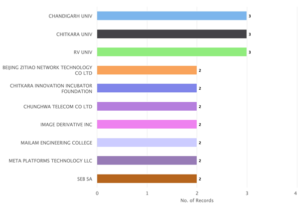
Figure 7: AR Technology Distribution of Patent based on Current Owner
As indicated in Figure 7, Chandigarh University is the major player with 03 patents along with Chitkara University and RV University each. The next key players are Beijing Zitiao Network Technology Company Ltd., Chitkara Innovation Incubator Foundation, Chunghwa Telecom Company Ltd., Image Derivative Inc, Mailam Engineering College, Meta Platforms Technology LLC and Seb S.A who holds 02 patents each.
K. Estimated top 10 Assignee Countries between 2022 and 2024
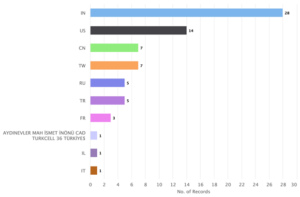
Figure 8: Distribution of Patent based on Assignee Countries
The Figure 8 indicates India (IN) is the key assignee country with 28 patents followed by United States (US) with 14 patents, China (CN) and Taiwan (TW) with 07 patents each, Russia (RU) and Turkey (TR) with 05 patents each, while France (FR) with 03 patents. The lowest include Turkcell Technology Arastirma ve Gelistirme A.S (TR), Israel (IL) and Italy (IT) with 01 patents each.
L. Estimated top 10 Priority Countries between 2022 and 2024
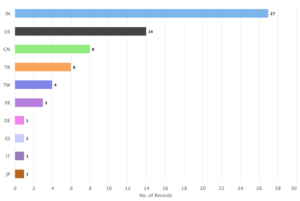
Figure 9: Distribution of Patent based on Priority Countries
As indicated in Figure 9, India (IN) is the priority country for the AR with 27 patent family data set. United States (US) is another priority country with 14 patents. Rest priority countries are China (CN) with 08 patents, Turkey (TR) with 06 patents, Taiwan (TW) with 04 patents and France (FR) with 03 patents. The lower half priority country include Germany (DE), Spain (ES), Italy (IT) and Japan (JP) with 01 patents each.
M. Estimated top 10 Publication Countries between 2022 and 2024
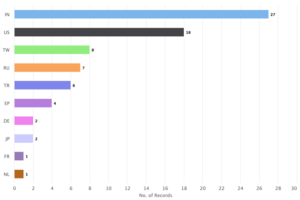
Figure 10: Augmented Reality Technology (AR) Distribution based on Publication Countries
The Figure 10 indicates that the maximum patents belongs to the inventors of India (IN) with 27 patents and rest patents are issued to the inventors of other countries, ie United States (US) with 18 patents, Taiwan (TW) with 08 patents, Russia (RU) with 07 patents, Turkey (TR) with 06 patents followed by European Patent Office (EP) with 04 patents, Germany (DE) and Japan (JP) with 02 patents each, and the least i.e, France (FR) and Netherlands (NL) with 01 patents each.
N. Analysis of ECG Suppliers
Analysis was performed in order to obtain the companies involved in Augmented Reality Technology. The list of companies involved in AR Technology comprises the companies from various parts of the world involved in AR production and the irrespective patents and publications. The companies have been mentioned in the analysis of the graphical representation of patent applications under each parameter used for patent landscape analysis.
Apart from the companies list, there are few universities involved in AR Technology (AR) production:
O. Conclusion
Augmented Reality Technology (AR), one of the most popular industrial instruments widely used in gaming and entertainment, health care, retail and e-commerce, education and training, manufacturing and maintenance, real estate and architecture, navigation, tourism, advertising and marketing, military and defense and automotive industry etc., has opened up new dimensions and vistas for diagnosis on an industrial scale. The study indicates that the substantial number of patents is filed by inventors of the IN (India) and Chandigarh University (Punjab) being the major player. The study also shows that there are very less patents filed when it comes to manufacturing industries when compared to computers and peripheral equipment. This sector is of growing interest as the amount of patenting activity has increased. The data shows that there are maximum published patent families related to the AR Technology worldwide, of which 29 are from IN (India) applicants. Based on the list of top applicants, it is clear the leading patent filers include the Chandigarh University, Chitkara University and RV University.
Authors: Ansh Kanaujia & Meghana Chowdary, Alliance University
Please contact us at info@origiin.com to know more about our services (Patent, Trademark, Copyright, Contract, IP Licensing, M&A of companies)
Subscribe to YouTube Channel HERE
Join LinkedIn Group: Innovation & IPR
WhatsApp: +91 74838 06607
Aug 29, 2024 | Contracts
A Contract aften has several provisions and terms agreed between the parties, depending upon purpose and the type of the Contract. The parties involved in the Contract must adhere to all the terms outlined in the contract. In a contract, both parties make promises to one another and failing to meet these obligations is regarded as a breach of contract. Each side promises to carry out a specific obligation, whether it is payment, delivery of goods, or services. When one party does not fulfil their end of the contract—in other words, they “fail to perform”—that party (known as the “breaching party”) has breached the contract.
There are two types of breach of contract:
- Material breach– which occurs when the contract is irreparably broken, and
- Immaterial breach– which is also known as a minor breach or simply a breach
While both types of breaches represent one party’s breach of the contract, only a material breach can result in actual damages or contract termination. In other words, the non-breaching party to a contract can only recover from a material breach. However, a significant difference exists between a minor oversight or failure to meet a small contractual detail and a complete [1]failure to fulfil any part of the contract. A major failure to perform is known as a material breach, while a failure to meet a more minor contractual obligation is considered a non-material breach.
A breach is considered material if its inability to perform is fundamental to the contractual contract[2]. When the purpose of the contract is not met and the contracting party does not receive the product or service for which they bargained and negotiated, this is considered a material breach.
The judge examined the concept of material breach in the case of National Power Plc v. United Gas Company Ltd (1998), [3]The court defined it as “a serious violation of any of the guilty party’s responsibilities.” Additionally, the judge ruled that failure to address a material breach within seven days would result in the termination of the contract.
On the contrary, a non-material breach occurs when a failure to perform is related to an irrelevant aspect of the contract, but the contract’s fundamental purpose has been fulfilled.
Examples of a Material breach
For instance, you own an event management business. Plans were in place for the catering crew to arrive early that day to set up for your Saturday night fundraising [4]dinner event. As per the terms of your contract, the caterer was to arrive at 4 p.m. and as a result, most of the food would have been ready for the dinner scheduled at 6 p.m. The caterers were unreachable and nowhere to be found when Saturday afternoon rolled around. When the company doesn’t respond and there’s no food, you decide to call off the fundraising event.
In this case, the contract was materially broken by the catering company. The quality of dinner served that evening made or broke your fundraiser. The caterer failed to show up, so you were forced to call off the event. The original intent behind entering the contract was thwarted by the catering company’s non-compliance.
Example of a breach/immaterial breach
A minor breach of a contract is called an immaterial breach. This kind of violation usually consists of a minor infraction that has no appreciable impact on the relationship. Although the other party may not have received what they had anticipated and the breach may be somewhat inconvenient, the variation does not nullify the contract or cause significant harm.
Let’s use the example of our fundraiser dinner from earlier. Let’s say, once more, that you hire a catering business to supply the food for a dinner fundraiser. According to the contract, the company must have the food mostly prepared by the time it arrives at 4 p.m. for the 6 p.m. dinner. The catering company informed you in the afternoon to let you know they’re running late and won’t be able to get to the event space until 5 p.m. However, the company guarantees that there won’t be a delay of more than fifteen minutes for dinner. The scheduled dinner is served at 6:15 p.m., and the caterer does arrive at 5 p.m.
Most likely, this breach would be regarded as unimportant as the caterers arrived late, so dinner was served later than scheduled. You were still able to conduct your event, and the dinner was still fully catered to all other specifications. Even though the situation was stressful, nothing significant changed in the end.
Consequences of a Material Breach
The consequences of a material breach of contract are significant and can have far-reaching implications. Legal implications for the party failing to perform include.
Lawsuits: The non-breaching party can sue for breach of contract. This could lead to a court case where the breaching party is held legally accountable for their failure to perform.
Court orders: Depending on the case, the court might order the breaching party to fulfill their contractual obligations, pay damages, or face other legal consequences.
Moreover, Section 73 of the Indian Contract Act, 1872 states that every party that breaches the terms of a contract need to compensate the non-breaching party whose rights have been affected as a consequence of the actions of the breaching party.
The principle established in the case of Hadley v. Baxendale forms the basis for this section. The case involved a mill owner (the plaintiff) whose operations were halted due to a broken crankshaft. The defendants were transportation providers tasked with delivering a replacement part. Due to the defendants’ delay in delivery, the plaintiff did not receive the crankshaft on schedule.
The court’s ruling established two key principles:
- In the event of a contract breach, the damages recoverable should be those that would naturally arise from such a breach under normal circumstances.
- If a party seeks to claim special damages, they must demonstrate that the other party was made aware of the potential for such specific losses at the time the contract was formed.
This decision set a precedent for determining the extent of damages recoverable in contract law, particularly in distinguishing between general and special damages.
Additionally, Section 74 of the Indian Contract Act, states that if a sum to be paid, in case of a breach, is mentioned in the contract then irrespective of actual damage caused or loss, the breaching party is liable to pay reasonable compensation, not exceeding the amount so mentioned in the contract. Accordingly, various types of damages can be sorted for by the aggrieved party.
Types of Damage
- Compensatory damages compensate non-breaching parties for losses caused by the breach. The goal is to put the non-breaching party in the same position they would have been if the breach had not occurred.
- Consequential damages, also known as special damages, are awarded for losses resulting from a breach, but not directly caused by it. They must be foreseeable and directly related to the breach.
- Punitive damages may be awarded for egregious breaches to punish and deter future misconduct.
Effect on contract performance for the non-breaching party
- Material breaches can significantly disrupt non-breaching parties’ business or personal plans.
- The non-breaching party may incur additional costs to find alternative solutions or mitigate the impact of the breach.
- The non-breaching party loses the benefit they would have received if the contract was completed as agreed.
It is critical for those facing a potential material breach situation to seek legal advice. Legal professionals can advise on the best course of action and help you navigate the complexities of contract law.
Remedies for a material breach of contract:
Legal actions available to the breached party- The party who was violated has the following different remedies at their disposal:
- Filing a lawsuit for breach of contract: If someone breaks a contract and doesn’t fulfil their end of the bargain, the simplest line of action is to sue them.
- Requesting a court order for specific performance: In some circumstances, particularly when monetary damages are insufficient, the non-breaching party may ask the court to compel the breaching party to carry out their obligations under the terms of the contract’s particular remedies, such as the termination of a contract
- Contract termination: In the event of a material breach, the non-breaching party may end the contract. As a result, they are no longer bound by the contract in any way.
- Recission of contract: This remedy voids the contract and attempts to put the non-breaching party back in the same situation as before the contract.
However, before you can terminate the contract or file for bankruptcy, you must give the other party notice that they have breached the contract. In your notice of breach, you should specify the nature of the breach, when it happened, and whether it can be remedied. Depending on the situation, trying to resolve the issue through negotiation may be more beneficial than filing for bankruptcy or terminating the contract.
Seeking payment or imposing obligations on performance:
- Making a damage claim: To make up for the losses brought on by the breach, the non-breaching party may make a compensatory damage claim. These are intended to restore the non-breaching party to the same position that they would have occupied in the absence of the breach.
- Enforcing the original terms of the contract: Where possible, the non-breaching party may pursue legal action to enforce the original terms of the contract if they still wish to see its terms fulfilled. When a significant violation happens, it’s critical to record all supporting documentation and consult a lawyer to determine the best course of action.
Conclusion
In conclusion, understanding the nature and consequences of contract breaches is crucial in business and legal contexts. Material breaches fundamentally undermine the contract’s purpose and can lead to significant legal and financial repercussions, including lawsuits, damages, and contract termination. On the other hand, immaterial breaches, while still violations, do not typically result in severe consequences. When faced with a potential breach, it’s essential to document the situation, communicate with the other party, and consider seeking legal advice. The remedies available to the non-breaching party, such as compensation or contract termination, depend on the breach’s severity and impact. Ultimately, clear understanding and careful handling of contract breaches are vital for protecting one’s interests and maintaining business relationships.
Author: Sanshia Rebello, Christ Deemed to be University
Please contact us at info@origiin.com to know more about our services (Patent, Trademark, Copyright, Contract, IP Licensing, M&A of companies)
Subscribe to YouTube Channel HERE
Join LinkedIn Group: Innovation & IPR
WhatsApp: +91 74838 06607
Aug 25, 2024 | Patent
A. Introduction
Robotic vacuum cleaners (RVCs) are devices that autonomously navigate floor plans, utilizing onboard sensors and software to meticulously remove dirt, dust, and debris. The introduction of RVCs has demonstrably revolutionized the home cleaning industry by enhancing efficiency and liberating users from a traditionally time-consuming chore. This allows individuals to dedicate their time to more productive or leisure activities. They also provide consistent cleaning, maintaining a higher standard of cleanliness with regular use. Moreover, their compact design allows them to clean under furniture and in tight spaces that traditional vacuum cleaners might miss.
The technology used by the Robotic Vacuum Cleaner is different from that of the traditional vacuum cleaner. Some of these technological features are as follows:
The Sensor: This allows the device to navigate through the floor and avoid bumping into areas as well as falling from heights.
Short-Range Ultrasonic ToF: This is used to identify if the target surface is hard or soft, it is working on an average amplitude of a reflected ultrasonic signal. This technology senses the type of flooring (tile, carpet, or wood) and adjusts its cleaning effort accordingly.
VSLAM And LiDAR: This technology helps to build a virtual map of the room. Since they are viewing a virtual map of the room that they are going to clean they are capable of cleaning more efficiently covering the entire home.
Inertial Measurement Units (IMU): IMU sensors act like a compass and level for the robot sweeper. They track how it moves in all directions, including forward/backward, tilting, and turning. This allows the sweeper to “know” where it is and what it’s doing while cleaning.
B. Objective of this Patent Landscape
This Patent Landscape Report delves into the industry of robotic vacuum cleaners by analysing trends in patent filings. Our investigation focuses on three key areas: first, identifying emerging technologies and advancements that are shaping the future of robotic cleaning. Second, we examine filing patterns over the past decade (2014-2024) to understand how the industry has evolved and developed. Finally, the report sheds light on the key players who are driving innovation in this dynamic market.
To achieve these goals, we conducted an analysis of patents filed, published, and granted during the specified timeframe. Our search strategy employed a strategic combination of predetermined International Patent Classification (IPC) codes alongside targeted keywords. This approach ensured we captured the most relevant data to create a well-rounded picture of the robotic vacuum cleaner patent landscape.
C. Parameters used for patent landscape analysis
- Patenting trends for the years 2014 to 2024
- Distribution of patents based on assignees.
- Estimated top 10 publication countries
- Estimated top 10 assignee countries
- Estimated top 10 Priority countries
- Estimated top 10 industry areas
- Estimated top 10 owners between the years 2014 and 2024
- Technological classification based on IPC classification
- Activities of Competitors based on Area of Research (IPC)
1. Patenting trends for the years 2014 to 2024

Figure 1: Patent filing trend between the years 2014 to 2024
Figure 1 depicts the distribution of patents for RVC between the years 2014 to 2024, including both applications filed and granted patents. The graph shows that highest number of applications were filed in 2019 with 68 patents followed by 2018 with 61 patents. However, the lowest number of patents were granted in the year 2014 with 16 patents compared to 2022 with 59 patents and 2020 with 55 patents. Overall, filings for RVC patent families saw a gradual increase but a sharp decline as depicted by the 2023 graph.
2. Distribution of patents based on assignees

Figure 2: Distribution of Patents based on the Assignees
As observed in Figure 2, Miele & CIE KG is the key player with 82 patents. The next key player is the Sharkninja Operating LLC with 52 patents. Electrolux AB has 46 patents while Dyson Technology LTD. has 39 patents. Next in line is LG Electronic Inc. with 31 patents, Irobot Corp. with 24 patents and Koninklijke Philips NV with 21 patents. The Seb Sa and Vorwerk & Co. Interholding Gmbh come next with 12 patents. Lastly, we have Omachron Intellectual Property with 11 patents.
3. Estimated top 10 publication countries between the years 2014 & 2024

Figure 3: Distribution of Patents based on Publication Countries
Figure 3 indicates that the maximum patents belongs to the inventors of United States (US) with 183 patents and rest of the patents are issued to the inventors of other countries, ie European Patent Office (EP) with 100 patents, Japan (JP) with 71 patents, Germany (DE) with 53 patents, United Kingdom (GB) with 34 patents, Chinese Taipei (TW) with 26 patents being the prominent followed by Australia (AU) with 22 patents, India (IN) with 11 patents, Canada (CA) with 9 patents and the least Russian Federation (RU) with 8 patents.
4. Estimated top 10 assignee countries between the years 2014 to 2024
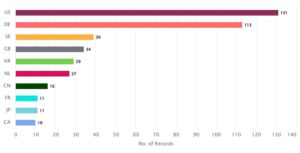
Figure 4: Distribution of Patent based on Assignee Countries
The Figure 4 indicates US (United States) is the key assignee country with 131 patents and rest assignee countries are Germany (DE) with 113 patents, Sweden (SE) with 39 patents being the prominent followed by Great Britain (GB) with 34 patents, Korea (KR) with 29 patents, Netherlands (NL) with 27 patents, China (CN) with 16 patents and France (FR) with 11 patents. The final three countries half include France (FR) with 11 patents, Japan (JP) with 11 patents and Canada (CA) with 10 patents.
5. Estimated top 10 priority countries between the years 2014 to 2024

Figure 5: Distribution of Patents based on Priority Countries
Figure 5 indicates that United States (US) is the is the priority country for “RVC “with 169 patents and the rest of the priority countries are Germany (DE) with 107 patents, European Patent Office (EP) with 62 patents, United Kingdom (GB) with 48 patents, Korea (KR) with 30 patents, Japan (JP) with 26 patents, China (CN) with 25 patents, France (FR) with 12 patents, Sweden (SE) with 11 patents and Chinese Taipei (TW) with 11 patents.
6. Estimated top 10 industry areas between the years 2014 to 2024

Figure 6: Top 10 industry areas between 2014-2024
The Figure 6 indicates major industries and technology areas between 2014 and 2024. Domestic Appliances is the major industry in the field with 446 patents. General Purpose Machinery follows next with 110 patents. The next in line is Measuring, Testing and Navigation industry with 63 patents. The Metal forming machinery industry holds 37 patents while the Other General-Purpose Machinery has 34 patents. The Computers and Peripheral Equipment has 28 patents followed by Communication Equipment with 26 patents. Motor Vehicles hold 25 patents while other manufacturing industries hold 20 patents. The least in number is the electric motors and generators industry with 17 patents.
7. Estimated top 10 owners between the years 2014 to 2024

Figure 7: Top 10 industry owners between 2014-2024
As depicted in Figure 7, Miele & CIE KG is the major player with 82 patents. Miele & CIE KG manufacturer of high-end home appliances and commercial equipment, known for their quality and durability.The next key player is Sharkninja Operating LLC. with 52 patents, which is a producer focused on designing and developing innovative household appliances.. The next in line is Electrolux AB. with 46 patents. Dyson James Ltd. industry holds 39 patents while the LG Corp. has 33 patents. Irobot Corp. industry has 24 patents followed by Koninklike Philips Nv. with 23 patents. Vorwerk & Co and Midea Group both holds 18 and 13 patents each followed by Seb Sawith the least number of patents i.e. 12 patents.
8. Technology classifications based on IPC classification

Figure 8: Technological Patent Distribution based on main IPC Code Classification
Figure 8 indicates the patent distribution based on main IPC code. The top spot is occupied by the domestic washing or cleaning with 589 patents families. Other major players include system for controlling or regulating non-electric variables with 126 patent families, manipulators with 69 patent families and radio direction with 32 patent families. Measuring distances, levels or bearings follows with 21 patents along with electric digital data processing with 20 patents . Circuit arrangements or systems for supplying or distributing electric power has 18 patents while the next in line ie. Brushes hold 16 patents. Air conditioning hold 13 patents each followed by Separation with the least number of patents i.e., 12 patents.
9. Activities of Competitors based on Area of Research (IPC)

Figure 9: Distribution of Patent based on Competitors and Area of Research (IPC)
Figure 9 depicts the distribution of patents based on competitors and area of research (IPC). The top spot occupied by IPC A47L9/28 ie installation of electric equipment hold 294 patents. Other major players include A47L9/04 ie driven brushes or agitators with 176 patent families and parts of machines not such as arrangment of switches, skirts, buffers, levers with 135 patent families. IPC A47L9/00 for details or accessories of suction cleaners with 129 patent families. Control of position or course in two dimensions with 121 patent families while next in line is floor sweeping machines and Nozzles with 38 patents. Lastly, we have A47L9/06 with fixed brushes and A47L9/14 with bags or the like at 35 and 34 patent families each.
D. Conclusion
Robotic Vacuum Cleaner (RVC), a newly introduced technology has slowly become one of the most popular pieces of technology and opened up new dimensions for the automated technological industry. The study indicates that the substantial number of patents is filed by inventors of the US (United States) and Miele & CIE KG (Germany) being the major players. The study also shows that there are very less patents filed when it comes to manufacturing industries when Domestic Appliances industry. Data shows that there are maximum published patent families related to the RVC worldwide, of which 131 are from US applicants. In terms of innovation, the RVC industry may be quite competitive despite the presence of a handful of very large companies. Based on the list of top applicants, it is clear the leading patent filers include the Miele & CIE KG, Sharkninja Operating LLC, Electrolux AB and Dyson Technology LTD.
Authors: Ambika Menon, O.P. Jindal Global University and Deeksha. S PES University
Please contact us at info@origiin.com to know more about our services (Patent, Trademark, Copyright, Contract, IP Licensing, M&A of companies)
Subscribe to YouTube Channel HERE
Join LinkedIn Group: Innovation & IPR
WhatsApp: +91 74838 06607
Aug 14, 2024 | Patent
A Patent of addition is a special type of patent allowing the holder to make improvements or modifications to an existing invention without filing a new patent application. It is designed to protect improvements or developments on an original patented invention, providing legal protection to the incremental innovations made by the inventor. The key feature of a Patent of Addition is that it derives its validity from the main patent and typically expires along with the main patent.
The Patents Act of 1970 is primarily based on the recommendations of the Justice N. Rajagopala Ayyangar Committee, as detailed in their report, “Report on the revisions in the patent law.” The Ayyangar Committee proposed the inclusion of a clause allowing for applications for patents of addition, similar to Section 26 of the UK Patent Act of 1949. In the UK, the Lord Swan Committee (1948) recommended provisions in the UK Patent Act 1949 to assist applicants who did not draft their claims comprehensively enough to cover their invention. This provision aimed to offer these applicants a chance to rectify their claims by filing a patent of addition, thus allowing them to address variations of the main application and expand the scope of their invention. The Ayyangar Committee’s recommendations mirrored Section 26 of the UK Patent Act.
The provision for a Patent of Addition offers significant benefits to inventors. It fosters continuous innovation by motivating inventors to enhance their inventions through incremental advancements. It also protects these enhancements, promotes cost and efficiency, and ensures clear legal protection for these improvements, empowering inventors to defend their innovations effectively.
- The Indian law for Patent of Addition.
Under the Patents Act of 1970 (Sections 54 to 56), a Patent of Addition is specifically designed to improve or modify an existing invention. This provision allows inventors to protect their incremental advancements without the need to file a new and separate patent application. The key feature of a Patent of Addition in India is that it does not have an independent term; instead, it expires concurrently with the main patent. This ensures that the improvement is protected only as long as the original invention is protected. A Patent of Addition can also be granted even if the main patent is still pending. It provides flexibility and continuous protection for ongoing innovations, reassuring and supporting inventors in their creative journey. The examination process for a Patent of Addition is the same as that for the main patent, ensuring that the improvement meets all patentability requirements, including novelty, inventive step, and industrial applicability.
Section 54 of the Patents Act of 1970 outlines the provisions for patents of addition, which are granted for improvements or modifications to an existing (primary) invention. If an applicant files for a patent covering an improvement or modification of a main invention and has either already applied for it or holds the patent, the Controller may, upon request, grant a patent for the improvement as a patent of addition. In case, the improvement or modification is already patented independently, and the patentee holds the main invention’s patent, the Controller may, upon request, revoke the independent patent and grant an addition patent with the same filing date as the revoked patent. A patent of addition is only be granted if its application date is the same as or later than the filing date of the main invention’s application, and it cannot be granted before the main invention’s patent is granted.
Further, Section 55 states that patent of addition is granted for the same term as the main patent and remains in force until the main patent expires or is revoked. If the main patent is revoked, the addition patent can become an independent patent for the remainder of the original term. No renewal fee is required for an addition patent unless it becomes independent. Lastly, Section 56 states that the grant of an addition patent cannot be refused or invalidated solely because the improvement lacks an inventive step compared to the main invention. The validity of an addition patent cannot be challenged because it should have been an independent patent. Novelty is assessed by considering both the main invention and the patent of addition.
- Can a Patent Cooperation Treaty (PCT) application be filed for an addition patent?
Section 54 of the Patents Act does not limit the type of application for which a modification or improvement can be sought, allowing flexibility in its application. According to Section 7(1A) of the Patents Act of 1970, an international application filed under the Patent Cooperation Treaty (PCT) is considered filed in India if a corresponding application was filed before the Controller in India. Furthermore, under Section 138(4) of the Patents Act, an international PCT application designating India is treated as if it were filed under Sections 7 and 54. Form-1, the standard application form for patents in India, includes a specific section dedicated to patents of addition, confirming that such applications can be filed domestically or through international routes.
This interpretation is consistent with the PCT itself. Article 2 of the PCT broadly defines “application” as various types of applications for the protection of inventions, encompassing patents of addition, among others. Therefore, if an applicant wishes to designate an international PCT application as a patent of addition or seek other forms of protection in the designated state, this can be indicated during the national phase entry process. However, it’s essential to consider whether the special privileges granted to patents of addition under Indian law are recognised and applied similarly in other jurisdictions where the PCT application is pursued.
- Comparative Analysis in the US, the EU, and Japan
In the United States, the concept similar to a Patent of Addition is known as a Continuation-in-Part (CIP) application, as defined in United States Code, Title 35, Section 253. A continuation-in-part (CIP) application is a refiling of the same specification as the parent application but includes additional features of the invention. The claims are directed to the additional features. A CIP application allows inventors to add new subject matter to an existing patent application while retaining the priority date of the original application for the shared content. This means that while the new material is examined as if it were a separate application, it benefits from the earlier filing date of the original application for the common content. This can be advantageous in securing earlier protection for the innovation. The term of the CIP patent can differ from that of the original patent, depending on the filing date of the new content, providing additional flexibility in managing patent lifecycles.
The European Patent Convention (EPC) does not have a direct equivalent to a Patent of Addition. Instead, it provides for divisional applications. A divisional application allows an applicant to split an existing patent application into two or more applications, each treated as an independent patent. Divisional applications must be filed while the parent application is still pending. They inherit the parent application’s filing date, ensuring that the priority is maintained. The term for a divisional application is 20 years from its filing date, providing a full patent term independently of the parent application. This approach offers inventors flexibility in managing their patent portfolios and protecting different aspects of their inventions separately.
In Japan, the concept of a Patent of Addition is provided under Article 44 of the Japanese Patent Act. It is also called “Utility Model Registration” or “Patent of Addition.” This provision allows inventors to patent improvements to an existing invention. Similar to India, the Patent of Addition in Japan does not have an independent term and expires concurrently with the main patent, ensuring that the improvement is protected for the same duration as the original invention. The improvement must meet specific criteria to be eligible, and the examination process is the same as for the main patent. This ensures that the added innovation is patentable and deserves protection.
- The Three Pillars of the Comparative Analysis
Term and Expiry: In India and Japan, the Patent of Addition expires with the main patent, ensuring no extension beyond the original patent’s term. This approach simplifies the management of patent durations but limits the protection period for improvements. In contrast, through CIP applications, the US system allows for a potentially different term based on the filing date of the new content, providing flexibility but adding complexity to patent term management. The EU’s divisional applications have independent terms, providing an entire 20-year protection period from the filing date of the divisional application and offering the longest potential protection for improvements.
Application Process: All jurisdictions require that the Patent of Addition or its equivalent undergoes the same rigorous examination process as the main patent. This ensures that the improvements meet all patentability criteria in India and Japan, even if the main patent is still pending. The US CIP application process allows for new subject matter to be examined independently, ensuring that each part of the application is thoroughly vetted. In the EU, divisional applications must be filed while the parent application is pending, maintaining a continuous chain of priority and ensuring that all aspects of the invention are examined appropriately.
Purpose and Use: All jurisdictions aim to encourage and protect incremental innovations and improvements. The US and EU systems provide more flexibility, with independent terms for CIP and divisional applications, allowing inventors to manage their patent portfolios strategically. This flexibility can be beneficial for complex inventions with multiple improvements. On the other hand, India and Japan offer a more straightforward approach, directly linking the term of the Patent of Addition to the main patent, simplifying the process but limiting the protection period for the improvements. This approach is beneficial for ensuring the improvement’s protection is tied to the original invention’s lifecycle, promoting consistent and predictable patent management.
Conclusion
The concept of a Patent of Addition plays a vital role in the global patent system by encouraging and protecting continuous innovation. Despite the varied implementations across different jurisdictions, the core objective remains consistent: incentivising inventors to improve and refine their inventions by providing legal protection for these incremental advancements. In India and Japan, the Patent of Addition ensures that improvements or modifications are protected as long as the main patent is in force. This approach simplifies the patent lifecycle for inventors by directly linking the improvement’s protection to the primary patent’s term, reducing administrative burdens and costs associated with filing multiple patents for related innovations.
The Continuation-in-Part (CIP) application in the United States offers a flexible mechanism for protecting improvements. By allowing the addition of new subject matter to an existing application and examining it independently, the CIP system allows inventors to extend the protection of their innovations while maintaining the original priority date for shared content. This flexibility can be particularly beneficial in industries where rapid technological advancements necessitate frequent updates and improvements to patented inventions. The European Patent Convention (EPC) adopts a different approach through divisional applications. Divisional applications allow inventors to split an existing patent application into separate patents, offering the advantage of independent terms and an entire 20-year protection period for each divisional.
Understanding these differences is crucial for inventors and businesses seeking to protect their innovations in multiple regions. The choice of jurisdiction and the specific type of patent application can significantly impact the scope and duration of protection for incremental improvements. By navigating the varied legal frameworks effectively, inventors can maximise the protection of their innovations, encourage continuous development, and strategically manage their intellectual property portfolios on a global scale. While the implementation of the Patent of Addition varies across India, the US, the EU, and Japan, each system aims to balance the rights of inventors with the public interest, fostering an environment that supports ongoing innovation, economic growth, and technological advancement.
Authors: Atriyo Bhattachary, School Of Law, Christ (Deemed to be University)
Please contact us at info@origiin.com to know more about our services (Patent, Trademark, Copyright, Contract, IP Licensing, M&A of companies)
Subscribe to YouTube Channel HERE
Join LinkedIn Group: Innovation & IPR
WhatsApp: +91 74838 06607
Aug 2, 2024 | Patent
Introduction
Cisplatin is an alkylating agent that reacts with biological components to form covalent bonds, commonly used in chemotherapy. It is a platinum based coordination complex that damages DNA in an unrepairable way. This halts the excessive growth of cancer cells and induces apoptosis. It is commonly administered for testicular, ovarian, bladder, and lung cancers.
However, one of the major side effects of Cisplatin was reported to be severe nephrotoxicity that is defined by deterioration of the kidneys due to heavy chemicals. To overcome this, a targeted drug delivery system using nanoparticles was devised.
Nanoparticles are spherical polymers with more than one dimension in the nanoscale. By scaling down the dimensions to the nanoscale, a drug’s efficiency can be increased by improving the drug’s absorption. They are biocompatible and biodegradable particles. Due to the nano-dimensions of the nanoparticles, there is an increased surface area that leads to increased absorption in the biological systems.
Cisplatin Nanoparticle formulations involve incorporating the targeted drug molecule with a nanoparticle that are engineered to target cancer cells and minimize side effects by not attacking healthy cells. Nanoparticles release the drug in a controlled manner, improving the drug’s bioavailability. Bioavailability is the extent at which the drug enters the human circulation system and is available for action on the active site. It is a parameter to judge the extent of a particular drug molecule’s absorption by the system and efficiency at the target site.
Cisplatin nanoparticles have been presented as a promising advancement in chemotherapy, offering a large therapeutic effect while minimizing the harmful side effects.
- Objective of Patent Landscape
We, at Origiin, prepared this Patent Landscape Report for Cisplatin Nanoparticle Formulation to understand various trends with regard to patent activity in this space. We have analyzed the patents filed, published and granted between 2019 and 2024. The search strategy used to generate the data to prepare the report is based on specific keywords.
We observed that the companies based in the US, China, Europe, Japan and Korea are major contributors of patent filings in the area of Cisplatin Nanoparticle Formulation. The leading patent filing companies include the Hangzhou Dac Biotech Co LTD, Legochem Bioscience Incorporated, University of California, Mayo foundation for Medical Education and Research and University of Chicago.
Search Strategy
PatSeer, a leading research platform for patent insights, was utilised for the landscape report to analyse the patents involving cisplatin nanoparticle formulation from the year 2019 till June of 2024.
The input search query was a combination of keywords and Boolean operators. The time frame was adjusted and an output of 2000+ records was obtained.
Based on this output, the patenting trends, competitors, top industries and top priority countries were analysed, and the data was presented graphically.
- Parameters used for Patent Landscape Analysis
In this report, we studied the following parameters and trends:
- Patenting Trends from 2019 to 2024
- Distribution of Patents based on the Assignees
- Global Patent Filing Trends
- Technology classification based on IPC classification
- Activities of Competitors based on Area of Research (IPC)
- Estimated Top 10 industries and technology areas between 2019 and 2024
- Estimated Top 10 owners between 2019 and 2024
- Estimated Top 10 Assignee Countries between 2019 and 2024
- Estimated Top 10 Priority Countries between 2019 and 2024
- Estimated Top 10 Publication Countries between 2019 and 2024
- Patenting Trends from 2019 to 2024
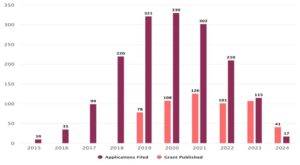
Figure (1): Patenting Trends from 2019 to 2024
Figure 1 depicts the patents filed for Cisplatin Nanoparticle Formulation from the years 2015 to 2024 and patents granted from 2019 to 2024. The graph indicates the highest number of filed patents in the year 2020 with 330 patents. It was followed by a decrease to 302 patents in 2021. It further reduced to 210 patents in 2022 and 115 in 2023. The filing of patents has gradually decreased from 2020 to 2024.
- Distribution of Patents based on the Assignees

Figure (2): Distribution of Patents based on the Assignees
Figure 2 showcases the top companies, Hangzhou Dac Biotech Co LTD holding 145 patents on Cisplatin Nanoparticles. Legochem Bioscience Incorporated takes second place with 76 patents. The next keyholder is the University of California with 66 patents. Mayo foundation for Medical Education and Research holds 28 patents followed by University of Chicago. with 28 patents. University of Michigan holds 28 patents. Massachusetts Institute of Technology holds close to 25 patents. University of North Carolina at Chapel Hill holds 24 patents in its name for Cisplatin Nanoparticle Formulation. Gilead Science Inc holds 21 patents and the last assignee is Purdue Research Foundation holds 21 patents.
- Global Patent Filing Trends
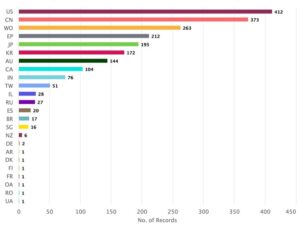
Figure (3): Global Patent Filing Trends
Figure 3 shows the distribution of patents across countries based on their jurisdiction. The maximum number of patents, ie 412, were filed in the US (United States) and rest of the patents were issued in the other jurisdictions, such as, China (CN) with 373 patents, World Property Organization (WO) with 263 patents, Europe (EP) with 212 patents, Japan (JP) with 195, Korea (KR) with 172 patents, Australia (AU) with 144 patents, Canada (CA) with 104 patents, India (IN) with 76 patents and Taiwan (TW) with 51 patents.
- Technology classification based on IPC classification

Figure (4): Technology classification based on IPC classification
Figure 4 indicates the patent distribution based on the main IPC code. The top spot is occupied by the preparation for medical, dental or toilet purposes with 1899 patent families. Other major players include therapeutic activity of chemical compounds or medicinal preparations with 1259 patent families, Peptides with 545 patent families and microorganisms or enzymes; preparations thereof with 263 patent families. Heterocyclic compounds follows with 153 patents. Investigating or analyzing materials by determining their chemical or physical properties follows with 140 patents. Specific uses or applications of nanostructures; measurement or analysis of nanostructures; manufacture or treatment of nanostructures has close to 118 patents. Measuring or testing processes involving enzymes holds 68 patents. Methods or apparatus for sterilizing materials or objects in general has 48 patents. Macromolecular compounds obtained otherwise than by reactions only involving unsaturated carbon-to-carbon bonds holds 45 patents, electrotherapy; magnetotherapy; radiation therapy; ultrasound therapy showcases 36 patents, sugars; derivatives thereof; nucleosides; nucleotides; nucleic acids has 31 patents, acyclic or carbocyclic compounds holds 28 patents and finally diagnosis; surgery; identification holds 23 patents.
- Activities of Competitors based on Area of Research (IPC)
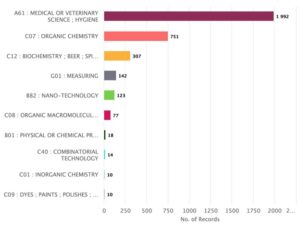
Figure (5): Activities of Competitors based on Area of Research (IPC)
Figure 5 depicts the distribution of patents based on competitors and area of research (IPC). The top spot is occupied by the Medicinal or veterinary science with 1992 patent families. Other major players include organic chemistry with 751 patent families followed by biochemistry with 307 patent families, measuring with 142 patents. Nanotechnology holds 123 patents, organic macromolecules with 77 patents, physical or chemical preparations with 18 patents, combinatorial technology with 14 patents and at the lower spectrum inorganic chemistry and dyes; paints; polishes with 10 patents each.
- Estimated Top 10 industries and technology areas between 2019 and 2024
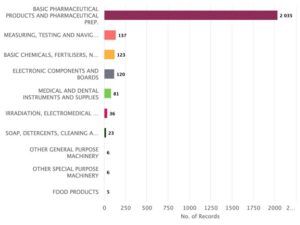
Figure (6): Estimated Top 10 industries and technology areas between 2019 and 2024
Figure 6 indicates major industries and technology areas between 2019 and 2024. Basic Pharmaceutical Products and Pharmaceutical Preparation holds an overwhelming 2,035 records. This is followed by the Measuring, Testing, and Navigating Instruments industry, which has 137 records, placing it as the second highest. Basic Chemicals, Fertilizers, and Nitrogen Compounds comes next with 123 records, closely trailed by Electronic Components and Boards with 120 records. The Medical and Dental Instruments and Supplies industry has a notable 81 records. Irradiation, Electromedical, and Electrotherapeutic Equipment has 36 records, while Soap, Detergents, Cleaning, and Polishing Preparations accounts for 23 records. Both Other General Purpose Machinery and Other Special Purpose Machinery industries each have 6 records. Lastly, the Food Products industry has the fewest records, totaling 5.
- Estimated Top 10 owners between 2019 and 2024

Figure (7): Estimated Top 10 industries and technology areas between 2019 and 2024
Figure 7 showcases that Hangzhou Dac Biotech Co LTD leads significantly with 145 records, indicating its substantial involvement in Cisplatin Nanoparticle Formulations. Legochem Bioscience Incorporated holds 76 records. University of California is also a major player with 66 records. Three entities— Mayo foundation for Medical Education and Research, University of Chicago and University of Michigan—each hold 28 records. The Massachusetts Institute of Technology is close with 25 records. The University of North Carolina at Chapel Hill holds 24 records. Both Gilead Science Inc and the Purdue Research Foundation possess 21 records each.
- Estimated Top 10 Assignee Countries between 2019 and 2024
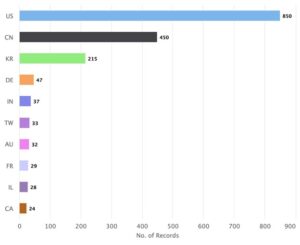
Figure (8): Estimated Top 10 Assignee Countries between 2019 and 2024
Figure 8 indicates US (United States) is the key assignee country with 899 patents and the rest assignee countries are issued to the inventors, China (CN) with 450 patents, Korea (KR) with 215 patents, Denmark (DE) with 47 patents, India (IN) with 37 patents, Taiwan (TW) with 33 patents, Australia (AU) with 32 patents, France (FR) with 29 patents, Ireland (IR) with 28 patents and Canada (CA) with 24 patents.
- Estimated Top 10 Priority Countries between 2019 and 2024
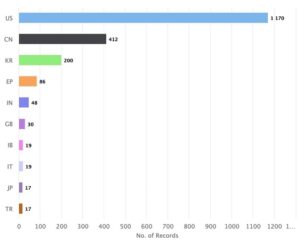
Figure (9): Estimated Top 10 Priority Countries between 2019 and 2024
Figure 9 indicates that the United States (US) is the top priority country for Cisplatin Nanoparticle Formulation with 1,170 patents. China (CN) follows with 412 patents, Korea (KR) holds the third position with 200 patents. The European Patent Office (EP) with 86 records. India (IN) has 48 records, and the United Kingdom (GB) has 30 records.
- Estimated Top 10 Publication Countries between 2019 and 2024
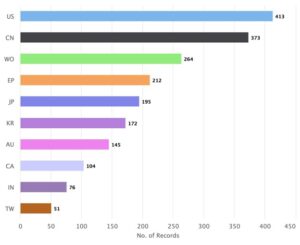
Figure (10): Estimated Top 10 Priority Countries between 2019 and 2024
Figure 10 indicates that the United States (US) is the top publication country for Cisplatin Nanoparticle Formulation with 413 patents. China (CN) follows with 373 patents, WO holds the third position with 264 patents. The European Patent Office (EP) with 212 records, Japan (JP) with 195 records, Korea (KR) with 172 patents, Australia (AU) with 145 patents, Canada (CA) with 104 patents, India (IN) has 76 records, and Taiwan (TW) with 51 patents.
- Analysis of Major Suppliers
An analysis was performed to study the patents filed for Cisplatin Nanoparticle Formulation for the past five years and list out the major companies involved in the formulation of said patents. From the patent analysis, certain key players working on cisplatin nanoparticle formulation were identified.
The companies have been mentioned in the analysis of the graphical representation of patent applications under each parameter used for patent landscape analysis.
Some of the major companies involved in Cisplatin Nanoparticle Formulations are:
Cisplatin Nanoparticle is emerging as a popular alternative in chemotherapeutics. It has gained popularity in the past five years, with the number of patents filed increasing from the years 2017 to 2020 by the pharmaceutical industries. The study indicates that a major portion of the patents filed belong to the United States followed by China.
The company Hangzhou Dac Biotech emerged as the major player. The study also showed that the Pharmaceutical industry holds the most patents, followed by the Measuring, Testing, and Navigating Instruments industry.
Based on the list of top applicants, it is clear the leading patent filers include the Legochem Bioscience Inc, University of California, Mayo Foundation for Medical Education and Research, University of Chicago, University of Michigan, Massachusetts Institute of Technology, University of North Carolina at Chapel Hill, Gilead Science Inc and the Purdue Research Foundation.
Authors: Nikhita JS, PES University and Tapas Das, IIT Kharagpur
Please contact us at info@origiin.com to know more about our services (Patent, Trademark, Copyright, Contract, IP Licensing, M&A of companies)
Subscribe to YouTube Channel HERE
Join LinkedIn Group: Innovation & IPR
WhatsApp: +91 74838 06607
































